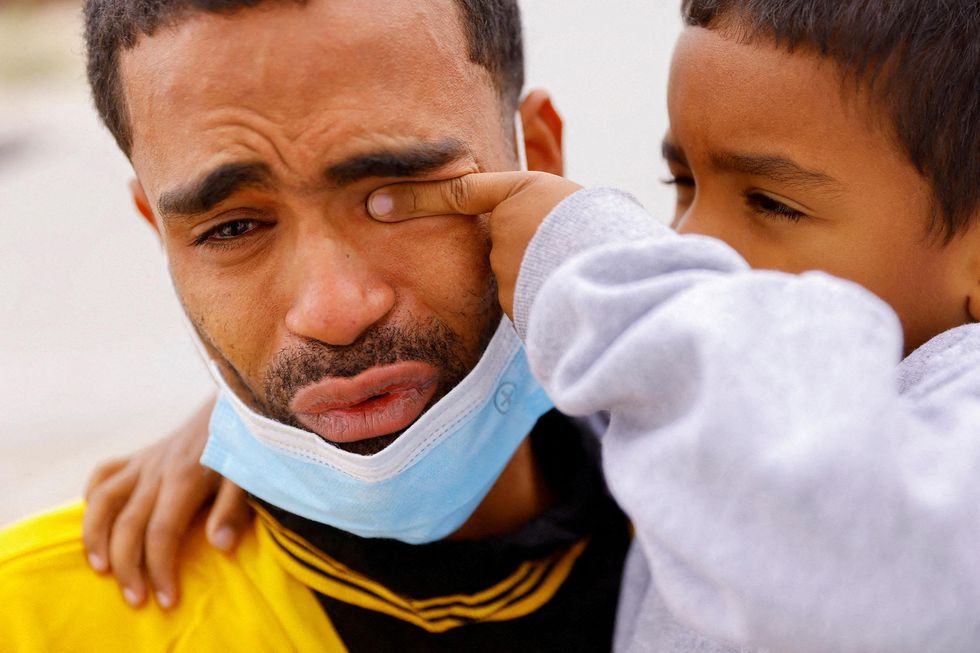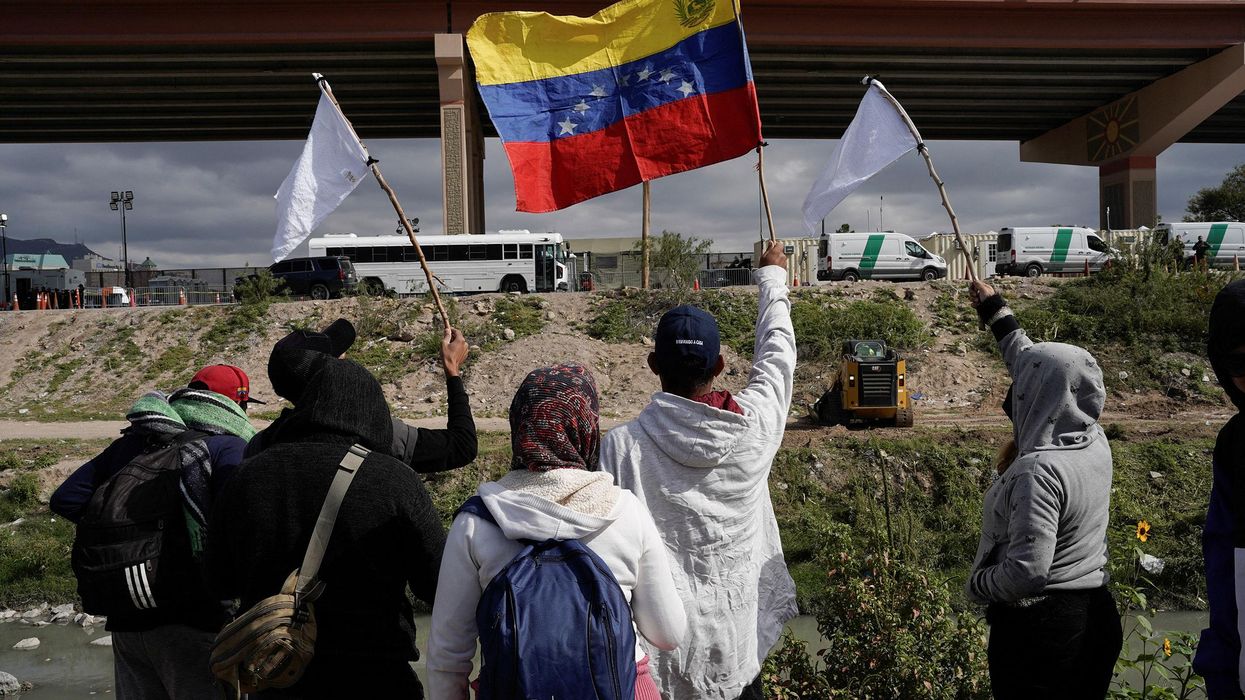(CNN) -- It's a striking image that reveals one family's struggle and a major change at the US-Mexico border.
A Venezuelan father's eyes well up with tears, and his 4-year-old son tries to wipe them away.
The photo -- taken in Ciudad Juarez, Mexico, this week by Reuters photographer José Luis González -- shows a man identified as Franklin Pajaro who'd just been expelled from the United States.
José Luis González
And there's more to the story beyond that powerful moment.
Here's a look at the bigger picture.
Officials made a major change targeting Venezuelans at the border.
Pajaro is one of thousands of Venezuelans kicked out of the United States as part of a new deal the Biden administration brokered with Mexican authorities.
Facing increasing pressure and criticism from state and local governments over growing numbers of migrants crossing the US-Mexico border, last week the Biden administration unveiled a new plan.
Now for the first time large numbers of Venezuelans are being subjected to the Trump-era public health authority known as Title 42, which allows officials to expel migrants into Mexico after they're apprehended at the border.
Why focus on Venezuelan migrants? Officials say the number of Venezuelans attempting to cross the border has spiked dramatically, nearly quadrupling in the past year.
And a growing number of Venezuelan asylum seekers have been among thousands of migrants bused from the border to New York City and other locations.
So far, since the new US-Mexico deal was announced on October 12, US authorities have sent more than 4,800 Venezuelans back across the border, according to the latest tally from the International Organization for Migration. And the number is growing daily.
Officials on the ground in Mexico describe an increasingly precarious situation. Dana Graber Ladek, chief of the IOM's mission in Mexico, said she's concerned to see Title 42 -- a policy the UN agency has long decried -- being applied now to more people.
"Most of the shelters are already at capacity. They're saturated," she said. "These individuals are being returned to cities that they don't know. They don't have their social networks. They don't have resources, and the numbers are quite high."
There's still hope for some Venezuelans trying to enter the US.
As part of the same new policy, the US also says it's creating a legal pathway for some Venezuelans to enter the United States via a process known as humanitarian parole.
The program, first reported by CNN, will allow up to 24,000 Venezuelans with US-based sponsors to fly into the US if they meet certain requirements, including passing a background check and completing vaccinations. Officials began accepting applications from potential sponsors this week.
The total number of people the US has said it plans to accept under the program is far lower than the number of Venezuelan migrants who've tried to cross the border this year, and it's unclear what will happen once the cap is reached. Officials have said depending what happens, they could decide to expand the program -- or end it.
On a call with reporters Thursday, advocates praised the humanitarian parole program and encouraged potential sponsors to sign up.
"This is a very tangible and impactful way that regular Americans, civic organizations can participate. ... We believe we have the capacity to welcome tens of thousands of more newcomers," said Cecilia Muñoz, a former Obama administration official who now co-chairs Welcome.US, which is hoping to help connect potential sponsors with Venezuelans trying to reach the United States. "Private sponsorship is a viable path forward."
Migrants are protesting... So are advocates.
But some migrants being sent back to Mexico as a result of the new policy have started to protest along the border.
Pajaro, the tearful father pictured with his son, told Reuters he'd already been in the US for six days with his wife and two children when they were sent back across the border into Ciudad Juarez.
"They left us on the street," he said, according to Reuters. "There are many families like us, and we're suffering."
Elsewhere in the Mexican border city across from El Paso, Texas, protesters -- including young children -- held signs asking to be reunited with family members in the United States. "I went through the jungle and they aren't letting me see my father," one girl's sign read.
In Washington and across the US, immigrant rights organizations are also criticizing the Biden administration's move, decrying the decision to turn to the controversial Trump policy that officials have been fighting to end in court.
"This decision comes after President Biden's declaration less than a month ago that the pandemic is over, highlighting the hypocrisy behind the continuation of the so-called public health order," Nicole Melaku, executive director of the National Partnership for New Americans, said in a statement last week.
"All people should have the right to seek safety and protection, not just a select few."
Why emotions are running high:
Previously Title 42 didn't apply to most Venezuelans, because Mexico had refused to accept their return and the South American country also wasn't accepting deportation flights. The new Biden administration policy changes that.
But many of the factors that have fueled Venezuelan migration in recent years remain the same.
Poor economic conditions, food shortages and limited access to health care, for example, are increasingly pushing Venezuelans to leave. More than 7 million Venezuelans are now living as refugees or migrants outside their country, matching Ukraine in the number of displaced people and surpassing Syria, according to the United Nations.
Over recent weeks, around 1,000 Venezuelans have been apprehended each day along the US-Mexico border, according to a Homeland Security official. To compare, just under 1,000 Venezuelans arrived at the US southern border in the entire month of February 2021, US government data shows.
Many migrants are fleeing desperate circumstances, and they've taken a long and difficult journey with the hope of reaching the United States. Recent photos and videos from the border reveal that emotions are running high.
Thousands have trudged through Panama's Darien Gap, a notoriously dangerous jungle crossing where migrants are forced to trek through mud and face other harsh conditions.
Some who were getting ready to cross the Darien Gap now say they don't know where to turn.
"After so much pain, so many obstacles we had to overcome, now we're stuck. We are in Necoclí (Colombia) and have nowhere to go," a Venezuelan migrant who asked to be identified only as José told CNN last week.
There's also a lot of misinformation circulating that complicates matters for migrants, the IOM's Graber Ladek said.
"We're putting out our own reliable information about the process and eligibility and what they need to do. ... For a Venezuelan migrant, it can be quite confusing," she said.
Is this a shift at the border or a 'PR stunt'? That depends who you ask...
The Biden administration's announcement last week drew immediate skepticism from some of the agents charged with enforcing it.
The National Border Patrol Council slammed the new Venezuela policy on Twitter as a "PR stunt" and argued there would be a cap to how many migrants Mexico accepts under the new plan.
An Associated Press report cited a Mexican government official stating that Mexico had only agreed to accept as many Venezuelans as the US welcomes via its humanitarian parole program. The Department of Homeland Security hasn't responded to a CNN inquiry about that report.
But officials in El Paso told CNN they're already starting to see things change in their city as result of the new approach.
On Wednesday afternoon due to a steep drop in arrivals, El Paso shut down its migrant center, where charter buses packed with migrants were heading to New York and other locations.
"At this point in time the numbers have subsided and we are scaling down our operations," Deputy City Manager Mario D'Agostino said.
He told CNN he attributed the sudden drop in migrant arrivals to the Biden administration's new policy and to what is known as "decompression," or the federal government's effort to reduce overcrowding in processing facilities.
For officials in the border city -- who'd warned they were overwhelmed and struggling to deal with the crisis -- it's a welcome relief.
For the Biden administration, it's a sign their new approach may be working.
But for Pajaro and others like him, the path ahead is far less certain.
The-CNN-Wire
™ & © 2022 Cable News Network, Inc., a Warner Bros. Discovery Company. All rights reserved.
- Why Did Will Smith Turn Down 'The Matrix'? - Advocate Channel ›
- Now Hear This on PBS - Advocate Channel ›
- Netflix: Somos - Advocate Channel ›
- J LO Didn't Want to Share the Stage With Shakira for the Super Bowl ... ›
- Happy National Popcorn Day: What Movies To Watch With The ... ›
- The Africa Channel: Lockdown - Advocate Channel ›
- What to Watch Today, June 30th - Advocate Channel ›

















































